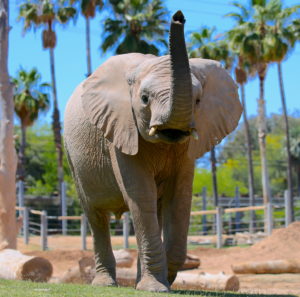What’s the Difference? African Elephants and Asian Elephants

What is the largest animal found on land? (Here’s a hint: It’s not a whale.) That’s right, it’s an ELEPHANT! Elephants can weigh more than 10,000 pounds, which is as much as a school bus! Reid Park Zoo is home to a herd, or group, of African elephants. African elephants live in — you guessed it — Africa, but did you know that elephants are also found on another continent? Asian elephants live in India and nearby countries in Southeast Asia.
How do you know whether you are looking at an African elephant or an Asian elephant? That’s easy, right? If you are in Africa, it’s an African elephant. If you are in Asia, it’s an Asian elephant. But what if you aren’t in either of those places? What if you are looking at a picture on the internet? Luckily, there are other ways to tell if you are looking at an African elephant or an Asian elephant.
Sometimes you can use size or tusks to tell the difference since African elephants are bigger and both boys and girls can grow tusks. However, using size or tusks isn’t always reliable, because you may come across an Asian elephant that is bigger than usual or an African elephant without any tusks that you can see. An easier way to tell the difference is to look at the elephant’s ears. Are they as big or bigger than the elephant’s head and shaped like the continent of Africa? If they are, then it is an African elephant. If the ears are small, then it is an Asian elephant. No matter the size of their ears, both types of elephants flap their ears to help keep cool.
There are other ways to tell African and Asian elephants apart, from the elephant’s trunk all the way to its feet. An African elephant has two “fingers” at the tip of its trunk for picking things up, a head that is rounded with one hump, a back that is concave or dips down from the shoulders, and three toenails on each back foot. An Asian elephant has one “finger” at the tip of its trunk, a head with two humps at the top, a back that is rounded or arched, and four toenails on each back foot. African elephants also have skin that is looser and looks more wrinkled than Asian elephants do.
Even though the types of elephants look different, they behave in a lot of the same ways. They live in herds that are led by the oldest female. Males leave the herd to live on their own or with small groups of other males. Older elephants are often poached for their longer tusks, leaving the herd without a leader who knows where food and water sources are. You can help elephants in the wild by not purchasing things made from ivory, and voting on measures to stop trafficking of wildlife products.
Fun Fact: There is actually a third species, or type, of elephant. It is called the African forest elephant. It looks a lot like the African savanna elephant that we just learned about, but is a little smaller and darker in color. It lives in the forests of Central Africa.
